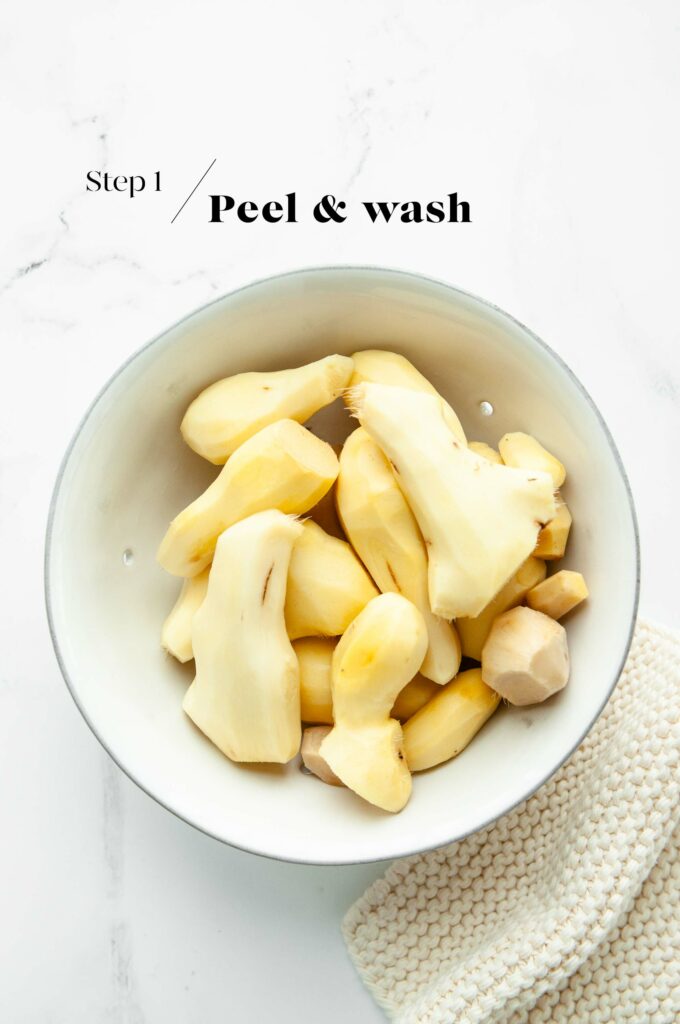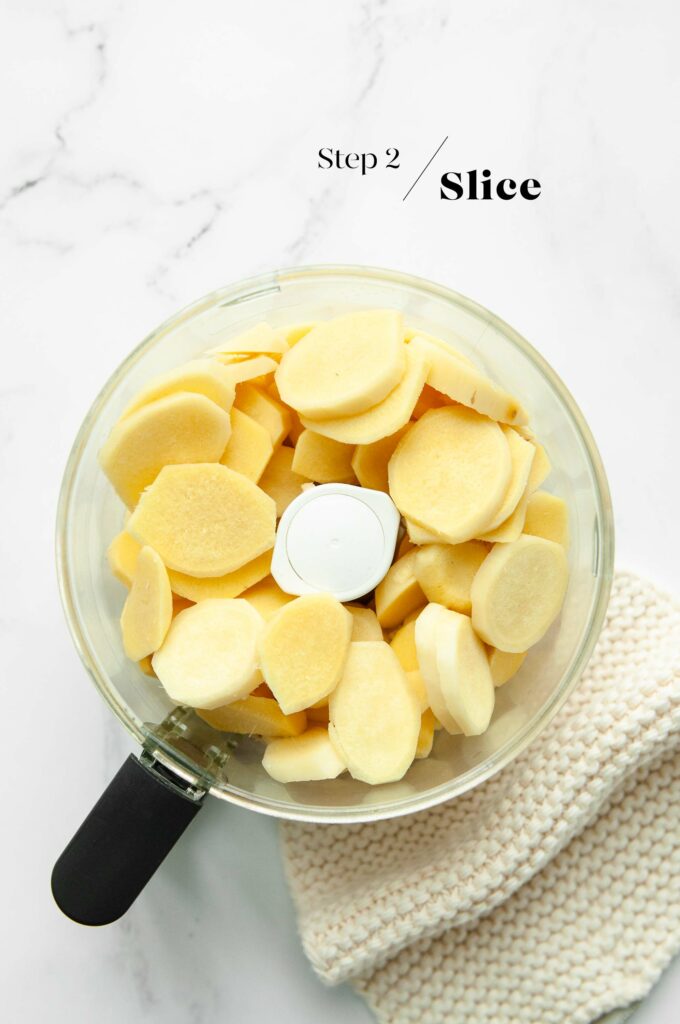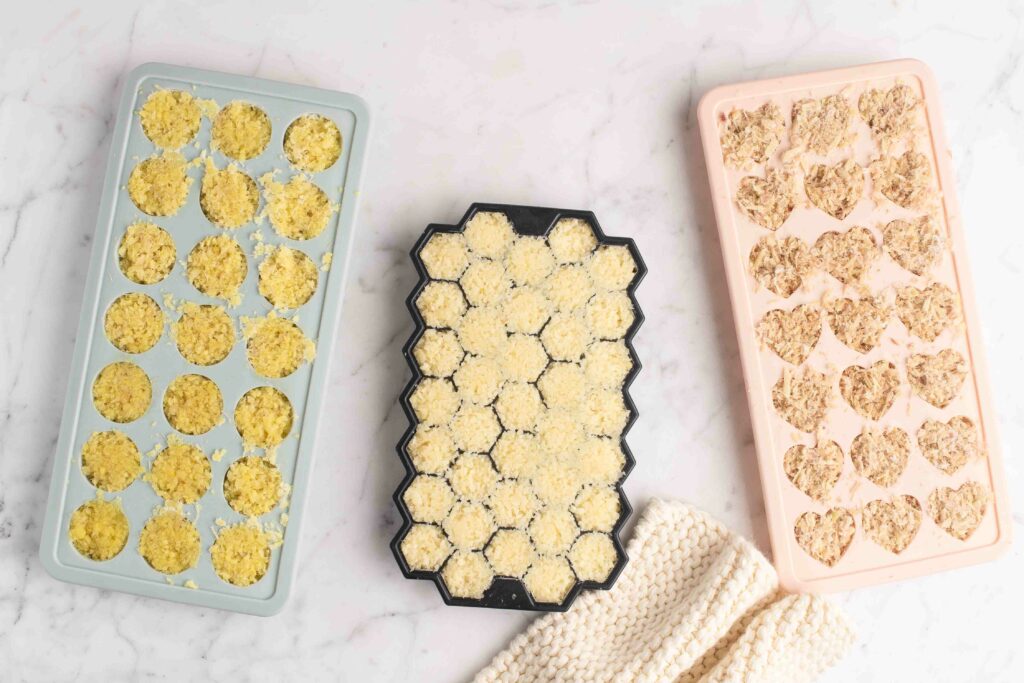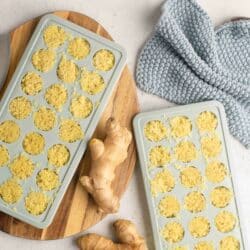How to freeze finely chopped ginger, ready to use in stir-fries and marinades. Recipe with step-by-step photos.

Freezing Ginger
In addition to freezing garlic and lemongrass, I regularly keep ginger in the freezer so that I always have some to hand for my stir-fries and marinades. I use to always keep fresh ginger in the fridge, cutting off pieces as and when I needed them, and storing the remainder in a glass container. Whilst there is absolutely nothing wrong with this process, and this is what I did for several decades, once I switched to freezing ginger in small cubes, it has been hard to go back.
Why You Should Freeze Ginger
Much like the arguments for freezing other aromatics such as garlic and lemongrass, freezing ginger means that you always have a supply ready to use, which can not only save on the time spent prepping fresh ginger each time you need to use it, but also save on the time spent shopping.
Although it might only take a few minutes to peel and chop a knob of fresh ginger, having it already frozen in cubes frees up mental space to focus on other tasks in the kitchen, especially if you are pushed for time.
In fact, I find it less stressful to cook knowing that I have some ingredients already prepped and ready to use, much like how a restaurant utilises a mise en place.

Freezing Fresh Ginger
Whilst nothing beats using fresh ingredients, using the freezer is an obvious way to extend the shelf life of many ingredients.
Some people will claim that frozen ingredients have less flavour than their fresh counterparts, and it is true that freezing food will dull the flavours somewhat, but frozen food still has flavour.
If you value convenience, freezing some fresh ingredients in advance can make cooking a faster and easier experience.
How to Freeze Ginger
There are several ways which I freeze ginger:
- Finely grated. I cook a lot of Asian food, and the majority of the recipes which I use call for finely gated ginger. This is because ginger is quite fibrous, and finely grating the ginger will remove the inedible fibres, allowing the ginger to meld with the dish nicely. For this task, I like to freeze the finely grated ginger in ice cube trays, as discussed below.
- Sliced thickly. The other times I use ginger is to flavour Asian stocks and broths. Here, I use thickly sliced ginger, which can be added in their frozen state to the cooking liquid.
Step 1
Peel the ginger. Depending on the shape of the ginger and how knobbly it is, I typically use a vegetable peeler to peel the ginger, and then a sharp-edged spoon for difficult to reach areas.
Once all of the ginger has been peeled, rinse the ginger under cold water to remove any dirt and bits of peel.
Roughly chop the ginger into thick slices.
If you frequently use ginger to flavour stocks and broths, freeze some of the ginger slices in a ziplock or silicone freezer bag.
Step 2
Place the ginger slices into the bowl of a food processor.


Step 3
Pulse the food processor, so that you can control how finely chopped the ginger will be. Most of the recipes I use call for finely grated ginger, so I like to process the ginger until the texture resembles finely grated ginger. But chop the ginger until the texture is to your liking.
Step 4
Transfer the chopped ginger to a silicone ice cube tray with a lid.
Depending on the ginger which you have used, there might be some juice from the ginger. Do not discard the juice, but make sure that it is mixed in with the chopped ginger.
Fill the ice tray completely with the chopped ginger, cover with a lid, and place in the freezer until the ginger is completely frozen.
Once the ginger is completely frozen, you can remove the ginger cubes from the ice tray and place them into a silicone freezer bag or plastic freezer bag.


How to Use Frozen Ginger
To use the frozen ginger cubes, let them stand at room temperature for about 10 minutes to soften and defrost before using. Alternatively, you can microwave the ginger cubes in short bursts until they have just softened.
When filling the ice cube trays with the chopped ginger, try to measure the capacity of each cube. The ice cube trays which I have used have approximately 1.5 teaspoon capacity when packed tightly, which I would equate to roughly 1.5 cm of ginger.
Some recipes call for a certain length of ginger to be used, e.g. 3 cm or 1 inch piece of ginger. In which case, I would use 2-3 cubes of frozen ginger.

Tips for Freezing Aromatics
If you would also like to organise your freezer with other aromatics, such as garlic and lemongrass, I recommend using different shaped ice cube trays to help you quickly identify the ingredients. For example, I freeze garlic in hexagonal shapes, ginger in round shapes, and lemongrass in heart shapes (it was the next best thing!). I store all of the frozen cubes in silicone freezer bags, and using different shapes means that I don’t have to label the bags.
Alternatively, you can use the same ice cube trays for various ingredients, but make sure you label the freezer bags well. Garlic and ginger look very similar when they are chopped and frozen, and you don’t want to confuse these two!
When looking for silicone ice cube trays, it is important to note the capacity of each indent (aim for 1-2 teaspoons), and a fitting lid is also ideal to let you stack the trays in the freezer, as well as to keep any smells contained.
Print
How to Freeze Ginger
- Prep Time: 30 mins
- Total Time: 30 minutes
How to freeze finely chopped ginger, ready to use in stir-fries and marinades. Recipe with step-by-step photos.
Ingredients
- fresh ginger
Instructions
- Peel the ginger using a vegetable peeler and/or sharp-edged spoon.
- Rinse the ginger under cold water to remove any dirt and bits of peel.
- Cut the ginger into thick slices.
- At this stage, you can freeze some or all of the slices of ginger for use in soups and stocks.
- To finely chop the ginger, place the ginger slices into the bowl of a food processor.
- Process the ginger to your desired texture. Many Asian recipes call for finely grated ginger, so I typically chop the ginger until it is quite fine, but not puréed.
- Transfer the chopped ginger to a silicone ice cube tray with a lid.
- If there is any juice from the ginger collected in the bowl, make sure you mix this with the chopped ginger.
- Place the tray in the freezer overnight.
- Once the ginger is completely frozen, remove the cubes of ginger and store them in a silicone freezer bag or plastic freezer bag.
- To use, place the desired quantity of ginger cubes at room temperature for about 10 minutes to soften and defrost. As ginger generally has a high liquid content, it will take longer to defrost than frozen cubes of garlic or lemongrass. Alternatively, you can microwave the frozen ginger in a small bowl in short bursts until it has just softened.
Kitchen Notes
 FOR HOW LONG CAN YOU FREEZE GINGER?
FOR HOW LONG CAN YOU FREEZE GINGER?
Unless food is vacuum-sealed for storage in the freezer, I would recommend using any frozen foods within 3 to 6 months.
 STORING GINGER IN THE FRIDGE
STORING GINGER IN THE FRIDGE
Any leftover chopped ginger which does not fit into the ice cube trays can be kept in a sealed glass container in the fridge for up to 1 week.
 CONVERSIONS
CONVERSIONS
To convert from cups to grams, and vice-versa, please see this handy Conversion Chart for Basic Ingredients.
 Print
Print Pin Recipe
Pin Recipe Rate
Rate